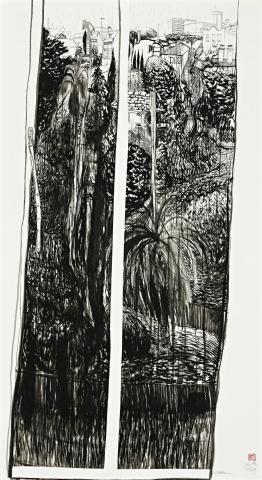JULY 2 1975 RAINY DAY - ALL DAY, 1975
BRETT WHITELEY
ink and collage on paper
162.0 x 89.5 cm
signed, dated and inscribed lower right: artist's studio stamp / July 2, 75 and monogram /'rainy day / all day / brett whiteley
Purchased from the artist's exhibition, 1975
Lawsons, Sydney, 12 December 1993, lot 192
Private collection, Melbourne
Sotheby's, Melbourne, 11 April 2006, lot 31
Private collection, Queensland
Brett Whiteley, Thirty six looks at four sights on three themes, recent paintings, drawings and carvings, Bonython Gallery, Sydney, 24 October – 15 November 1975, cat. 14
Park under sunlight, 1976, oil on canvas, 210.0 x 152.4 cm, collection of the National Gallery of Victoria, illus. in McGrath, S., Brett Whiteley, Bay Books, Sydney, 1979, p. 191
Using the window as a frame, Brett Whiteley invites the viewer to gaze out onto the lush gardens and the wilting trees that are being drenched by the rain. Buildings line the horizon while a glimpse of the Sydney Harbour Bridge is offered in the top right corner. July 2 1975 Rainy Day - All Day, 1975 is a particularly important picture for the artist, being a large and ambitious work on paper that made reference to Whiteley's life in Sydney. Whiteley returned to Australia in 1969 after nine years abroad and, after initially renting the top floor of the Lavender Bay property, in 1974 he and his wife Wendy purchased the house with panoramic views of Sydney Harbour, finding inspiration through 'the stunning harbour views in all their variation of mood and tone through the windows...'1 Whiteley went on to paint this scene a year later, replacing the rain with a sunlit glow in striking hues of gold and blue, titled Park under sunlight, 1976 (National Gallery of Victoria, Melbourne), once more utilising the window as a divide between the viewer and the exterior.
The window became a significant three-dimensional tool for Whiteley upon his return to Australia, creating a tangible object for the viewer to grasp. The picture on offer was exhibited at Whiteley's solo exhibition at Bonython Gallery in Sydney, 1975, along with seventeen other 'windowscapes'. The windowscapes dominated this solo show, comprising exactly half of the exhibition, which was divided into three categories: Windows, the River and Nudes. The central painting of this exhibition was Henri's Armchair, 1975, an important window scene. Providing an insight into Whiteley's psyche, this painting quotes Matisse's desire for a pure and serene art form 'devoid of troubling or depressing subject matter, an art which might be something like a good armchair in which to rest from physical fatigue'.2
Whiteley's first years in Lavender Bay signified the beginning of one of his greatest periods, an art form concerned with the 'concept of beauty, with sumptuous, glorious pictures celebrating the harbour and the birds, and the table tops too'.3 There were of course hints of his inner turmoil, such as escape routes plotted by ships as they coursed their way across the harbour, and the heavy rain and dark monotones of July 2 1975 Rainy Day -All Day evoke a poignant emotion. It was here at Lavender Bay that Whiteley found a somewhat uneasy peace; a reconnection with Australia that was shadowed by his tumultuous private life. Wendy Whiteley recalls the joy of returning home; 'In a sense Lavender Bay was Brett's return to paradise, having come from a very anxious situation - and it is paradise'.4 In the years that followed, Whiteley achieved great success as the winner of the Archibald Prize and Sir John Sulman Prize in 1976, the Wynne Prize in 1977, and all three in 1978.
1. Pearce, B., 'Persona and the Painter', in Pearce, B., Brett Whiteley: Art and Life, Thames and Hudson, Melbourne, 1995, p. 35
2. McGrath, S., Brett Whiteley, Bay Books, Sydney, 1979, p. 180
3. Wendy Whiteley, interviewed by Barry Pearce, 'Recollections', in Pearce, B., Brett Whiteley: Art and Life, Thames and Hudson, Melbourne, 1995, p. 48
4. Ibid.
CASSI YOUNG
